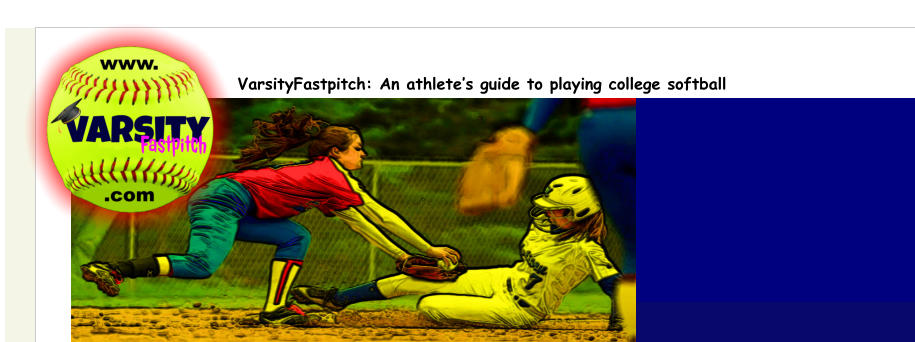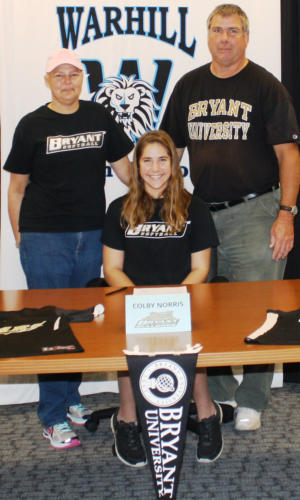





© 2015, 2018 Varsity Fastpitch. All Rights Reserved. The information provided is an estimate. Varsity Fastpitch and its creators are not responsible for errors.
College Selection Process

Our Mission:
To help high school softball
players find their way through the
complex and confusing maze of
identifying careers, finding
colleges that are a good match,
and navigating through the
recuiting process.
Colby
Norris
a
pitcher
from
James
City
County,
Virginia
signed
her
National
Letter
of
Intent
November,
2014
with
Bryant
University,
a
Division
I
school
in
Rhode
Island.
As
a
high
school
senior
getting
ready
to
graduate
with
a
4.0
grade
point
average,
it
would
seem
to
some
that
Colby
could
just
sit
back
and
wait
for
the
offers
to
come
in.
After
all
she
throws
a
fastball
in
the
mid
60’s,
gets
great
spin
on
her
pitches,
and
is
a
pretty
good
hitter
too.
Well,
it
just
doesn’t
work that way in the world of college recruiting.
Colby
started
her
college
recruiting
journey
when
she
was
11.
That’s
right
–
11
years
old.
Are
you
shaking
your
head
saying
that’s
too
early?
Well
it
isn’t
–
especially
for
pitchers.
Colby
attended
one
day,
two
day,
and
overnight
camps
as
a
way
to
provide
exposure
to
college
coaches.
It
also
gave
her
experience
performing
in
front
of
large
groups.
I
started
addressing
the
topic
of
college
recruiting
with
our
12u
program
last
year
and
we
are
working
through
the
process
with
our
14u
program
this
year.
The
steps
of
the
Alexander
Early
Recruiting
College
Selection
Process
are listed below.
STEP
ONE:
Student
athletes
need
to
have
an
idea
of
what
career
path
they
want
to
take.
I
provided
some
links
to
our
families
(many
resources
are
available
on
the
Internet)
that
help
students
think
about
their
future
careers.
Some
of
the
links
provided
career
selector
guides
and
even
some
interactive
web
pages
where
students
can
narrow
down
what
careers
they
are
interested
in
and
might
be
good
at.
Some
links
provided
information
about
what
types
of
jobs
will
be
in
demand
when
the
students
graduate
from
college.
One
thing
that’s
important
here
is
to
realize
that
middle
school
and
even
high
school
students
may
not
be
able
to
pick
a
definitive
career
or
one
that
doesn’t
change
many
times
before
they
graduate.
The
important
lesson
from
this
process
is
to
understand
the
process
itself.
There
are
many
benefits
for
student
athletes
who
can
actually
identify
a
career
early
on.
Many
students
who
identify
their
career
choices
early
can
set
goals
and
focus
on
achieving
these
goals
more quickly, more easily, and often with higher performance.
STEP TWO: Student athletes should consider school location. Many students fall into one or more of the following
categories which are extremely useful in narrowing their searches. Keep in mind the distances are approximate and can
be changed according to your own requirements:
•
Students want to live at home while going to school or students that want to stay close to home. This
geographically limits students to schools that are within commuting distance – roughly 60 miles.
•
Students with special needs. Depending on the needs of the student, there are typically two categories that are
useful. The first, is a student who needs to live at home, which limits the school’s distance to approximately 60
miles. The second, is for students that can live away from home but need to be accessible by parents within a few
hours by car. This limits the school’s distance to approximately 200 miles.
•
Students that want to choose a school in a particular region. For example, some students may want to select a
school in a warm climate, or a cool climate. This limits the available schools to those regions.
•
Students that don’t care about the location of a school.
•
Students that want to get away from home.
STEP THREE: Identify what type of school you want to attend. For the sake of this article, we will limit the discussion to
Division I, Division II, and Division III. Each of these three types of schools has their own attributes. You need to decide
what goals you want to meet by going to school: is softball your primary focus and your education is secondary, or is
your education the most important and softball is secondary. Three attributes that seem to be most important are:
1.
Focus on athletics
2.
Focus on education
3.
Availability of scholarships vs. financial aid
The following statements are gross generalities with many exceptions. Better definitions exist and can easily be found on
the Internet. Division I schools typically have more money to spend on athletic scholarships than Division II. Division I
schools focus on athletics as being very important, while Division II schools focus more on education. Division III schools
do not offer athletic scholarships, but need-based aid packages are typically available.
STEP FOUR: Students need to be honest with themselves and evaluate both their academic and athletic abilities.
Students with a high GPA, may be able to academically get into most schools. Student athletes with elite softball skills
may be able to make the cut in most softball programs. The combination of elite athletic ability and high GPA are rare.
Be honest with yourself when making the evaluation. If you are interested in attending a Division I school, but your
softball skills aren’t near the top of your team, you may need to rethink this category. Similarly, if your grades aren’t that
great and you’re interested in attending an academically competitive school, you may need to look elsewhere.
STEP FIVE: By this step you know what career path you want to take, geographically where you want to attend school,
what Division school you want to attend, and you’ve performed and honest assessment of both your academic and
athletic abilities. You now use the results of STEPS ONE through FOUR to narrow your search. Lists of schools in the
Division you are interested in can be found on the Internet. Use the following checklist to narrow your search of schools
in the desired Division. If you can’t “check off” each category, then move on.
•
This school is located in the region I want/need
•
This school has a program that supports my career path
•
This school has a softball program
•
This school is within my reach academically
•
This school is within my reach athletically
STEP SIX: Now you should have a master list of ALL schools that fit your basic requirements and are within your reach to
attend. Keep in mind that many college selection processes will talk about having a “backup” or “safe” school you know
you can easily get into as well as a stretch school that you may not be able to get into on your prospect list. You should
also include these schools in this process as well. However, our focus is on the middle part of the fit curve – the schools
that most closely meet your requirements and skills. Start researching the schools on your list. There are many resources
that can provide advice on what attributes you should consider when selecting a college. Try to narrow your list down to
15-20 schools.
STEP SEVEN: You’ve made a lot of progress by this step and you now have a narrowly focused list of 15-20 schools you
are interested in attending and playing softball for. The next step is to further narrow your list down to your top 5-10
favorite schools. Then identify the top 2 schools on your list. Finally, check out the websites for each of these programs.
If camps and clinics are listed, make note of the details on a calendar. If nothing is listed, then email the contact address
asking to be notified when camps and clinics will be held. The idea here is to make initial contact with the coaching staff
by attending their camps and clinics. You should try to attend the camps and clinics held by the top two schools you
identified as often as possible, and at least every year.
STEP EIGHT: Now that you have a calendar of camps and clinics you want to attend. Work with your parents to select
camps and clinics that meet your family’s schedule and budget. Once you have this finalized schedule in place, be sure to
register early for each camp or clinic. About two weeks prior to each, mail (by physical snail mail ONLY) the coaches
holding the camp or clinic the following: a handwritten note telling them you are interested in their program and that
you will be attending their event, a player profile sheet (there are many examples on the Internet), and a list of the
upcoming travel games you will be playing in if they are known.
The process doesn’t end at step eight, but student athletes can follow this process through their freshman year. If you’re
currently a freshman or older and you haven’t performed these steps, you need to begin as soon as possible! Student
athletes should run through the entire process at least annually if any of the decisions used in school selection have
changed. Next steps include registering on the NCAA Eligibility Website, playing in showcase tournaments, taking
informal school visits, creating a skills video, and keeping coaches on the top 15-20 list updated on your progress,
including academic and athletic achievements. A great resource that EVERY prospective college softball player should
buy is Preparing to Play Softball at the Collegiate Level by Catharine Aradi. It can be purchased through the NFCA
website.
Coach Sue Enquist has commented many times that she and other coaches evaluate MANY other attributes of student
athletes besides their grades and playing skills. You need to be very careful about how you use social media. Never post
anything that is inappropriate or can be interpreted as inappropriate. Coaches are very interested in your character. They
want to see that you are involved in charity and community work. They watch you as you are arriving at the practice
field. They want to see how you interact with your family members as well as with the other players.
Colby Norris attended clinics since she was 11 years old, and narrowed her focus to 15-20 schools when she started
playing 14u. She took her first SAT in her sophomore year and started playing in showcase tournaments. Having an early,
high SAT score is a great way to draw attention to yourself! All Division I and II schools prefer to select players who are
high academic performers as these student athletes may also be eligible for academic scholarships which helps coaches
have more athletic scholarship money available to obtain other great players. So make sure you keep working hard at
your GPA and SAT scores!














